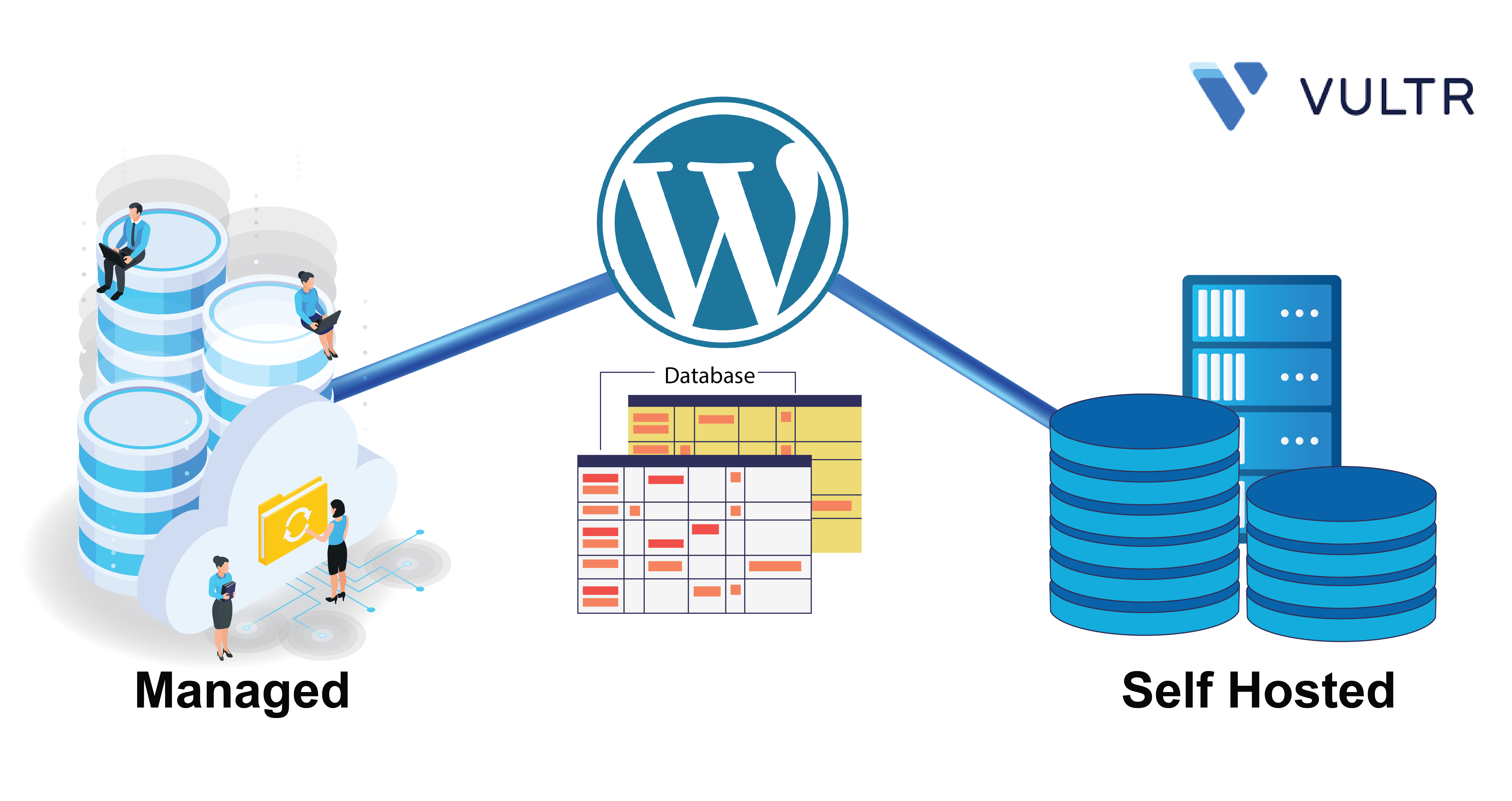Choose WordPress Database Backend: Managed MySQL vs Self Hosted

Introduction
A WordPress database is a key backend component that determines the general site performance, responsiveness, and reliability. Depending on the number of WordPress database calls, your site response rate matches the rate at which the data requests get processed back by the database server.
A self-hosted database involves deploying a local or remote MySQL database server that handles all WordPress processes. Commonly, a database server runs on the same infrastructure as the WordPress server and shares the same system resources. In case of a system failure, the database server breaks together with the WordPress application.
A managed database is a cloud-hosted solution that includes enhanced features for production environments. When WordPress connects to a managed database, resource dedication improves in a way that the database does not use the CMS server resources in any way. In cases where the WordPress database is huge in size, a managed database scales to handle all application requests.
This article explains how to choose a WordPress backend database. You are to run a managed database versus self-hosted comparison, consider the best choice, and deploy it to your WordPress site.
Managed Database Versus Self Hosted Database
Both managed databases and self-hosted databases can work as the main WordPress backend to handle all application requests. However, the database systems offer different features that can enhance your WordPress site performance and reliability as described below:
Managed Database
- Highly Scalable
- High Availability
- Fully managed by a 3rd party support team
- Optional Graphical Interface
- Managed Automatic Backups
- High Convenience with little focus on the Database Infrastructure
- Costly with predictable pricing
- Requires little to No advanced Database management skills
Self Hosted Databases
- Little to No manual scaling operations
- Server-Uptime based Availability
- Non-Managed and requires a dedicated database administrator
- Self hosted Graphical Interface such as PhpMyAdmin
- Manual Backups as set by the Database Administrator
- Advanced Control with full access to the Database Infrastructure
- Cost-friendly as Infrastructure runs other hosted services
- Requires database management and maintenance skills to keep the server running
In summary, a managed database offers more convenience and offloads critical database management tasks from your server. This allows you to focus on other services associated with your WordPress site functionality.
In comparison, a self-hosted database offers more control over the database server functionality, but requires advanced skills to fully manage the available databases. This means you must control all services linked to your WordPress site, and fully troubleshoot the database server in case of an error.
The Best WordPress Backend Database Choice
You can choose the best backend database system for your WordPress system based on the following three factors:
- Average WordPress site traffic
- The size of your WordPress technical management team including database administrators, backend and frontend developers
- Number of database systems linked to your WordPress site
Depending on your WordPress site category, if you receive millions of site visitors per month, you need a highly available database system making a managed database the best choice. However, if you have a low-traffic WordPress site with fewer database calls, use a self-hosted database.
If you have a team of less than 5 developers managing a high-traffic WordPress site, you can offload database infrastructure management tasks by migrating to a managed database. This allows the rest of your technical team to focus on improving other WordPress site functionalities and less on the backend database performance.
When running multiple database systems on your WordPress site, for example, a MySQL database, and a Redis® database. It's important to separate the database servers to ensure high availability and recovery in case of site crashes. In this case, you can deploy a self-hosted Redis® database, and the main backend managed MySQL database.
Conclusion
In this article, you discovered the differences between a managed database and a self-hosted database. Depending on your WordPress site requirements, it’s safe to deploy a hybrid database system in a way that you can run both a managed database and a low-resource self-hosted database. To synchronize the database systems, enable data replication to allow quick database recovery in case of any errors.
Next Steps
Depending on your deployment choice, visit the following resources to either deploy a Vultr Managed Database or a self-hosted database on your server.
- How to Boost WordPress Performance with Vultr Managed Databases for Caching
- How to Setup Redis® Caching for WordPress with Ubuntu 20.04 and Nginx
- Harden WordPress Security with Vultr and Cloudflare
- How to Serve WordPress Assets using Vultr Object Storage
- How to use Vultr Managed Databases for MySQL with WordPress on Ubuntu 20.04
- How to Install WordPress on a Subdomain with Nginx
- Migrate WordPress Websites from cPanel or Plesk to Vultr
- WordPress Database Backend: Managed MySQL vs Self Hosted
- Serve WordPress Assets using Vultr Object Storage
- WordPress Object Cache with Vultr Managed Database for Caching
- Backup a WordPress Website using 3-2-1 Strategy
- Manage your WordPress Website with WP-CLI
- Bring WordPress to the Edge with Vultr and GeoDNS
- Harden WordPress Security with Vultr and Cloudflare
- Common WordPress Troubleshooting Guide